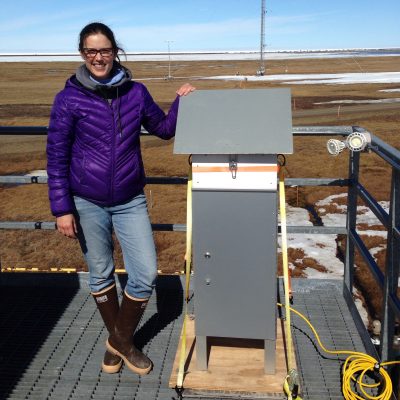ARM Field Campaign in Alaska Appears in Environmental Publication Ensia
Published: 13 June 2017

An ARM Climate Research Facility field campaign was featured in an article by the environmental online magazine Ensia on the relationship between black carbon and climate.
The Summertime Aerosol Across the North Slope of Alaska (NSA) field campaign, which took place in 2015 and 2016, is providing greater insight into the sources, composition, and amounts of tiny atmospheric particles at ARM’s Oliktok Point and Barrow atmospheric observatories. Kerri Pratt of the University of Michigan served as the field campaign’s lead scientist, and Rebecca Sheesley of Baylor University was the co-investigator.
At the same time, as part of a National Oceanic and Atmospheric Administration field campaign, Pratt and Sheesley investigated the atmospheric particles that came from oil and gas extraction activities near the NSA. A discussion paper on this research is under review for the journal Atmospheric Chemistry and Physics.
“I think it’s a great example of a collaboration between agencies to make really exciting and important science happen,” Pratt says.
Of particular interest to the scientists is black carbon—more commonly known as soot. Black carbon has significant effects on the environment, particularly in the Arctic. When soot blankets snow or ice, it leads to faster melting. In the atmosphere, black carbon absorbs and gives off heat, which contributes to climate warming.
Researchers used a single particle mass spectrometer called “Maverick,” which zapped particles to help reveal a chemical fingerprint that can be traced to their source. Combining that with radiocarbon analysis, scientists found the biggest sources of black carbon in the Alaskan atmosphere were the North American Arctic and Russian Arctic.
Pratt told the Ensia article writer, Madeline Ostrander, that the Arctic landscape is different from when she started working in Alaska five years ago.
“It’s actually pretty amazing,” Pratt says. “You can see the changes in the ice just in that time frame. It’s quite shocking actually to see it firsthand.”
The work is far from over for Pratt and Sheesley. Pratt is part of ARM field campaigns that focus on measuring and determining sources of ice nucleating particles at Oliktok Point. Sheesley, who was the lead scientist for the Barrow Black Carbon Source and Impact Study in 2012 and 2013, is working on an ARM field campaign to help understand the influence of atmospheric particles on the NSA’s energy imbalance.
Ensia, which covers global environmental issues, is an independent publication that receives support from the Institute on the Environment at the University of Minnesota. Ostrander visited the NSA with support from the Fund for Investigative Journalism. Ostrander’s story also got picked up by Climate Central, an independent group of scientists and journalists who conduct and report on climate science research.
The ARM Climate Research Facility is a DOE Office of Science user facility. The ARM Facility is operated by nine DOE national laboratories.
Keep up with the Atmospheric Observer
Updates on ARM news, events, and opportunities delivered to your inbox
ARM User Profile
ARM welcomes users from all institutions and nations. A free ARM user account is needed to access ARM data.


















